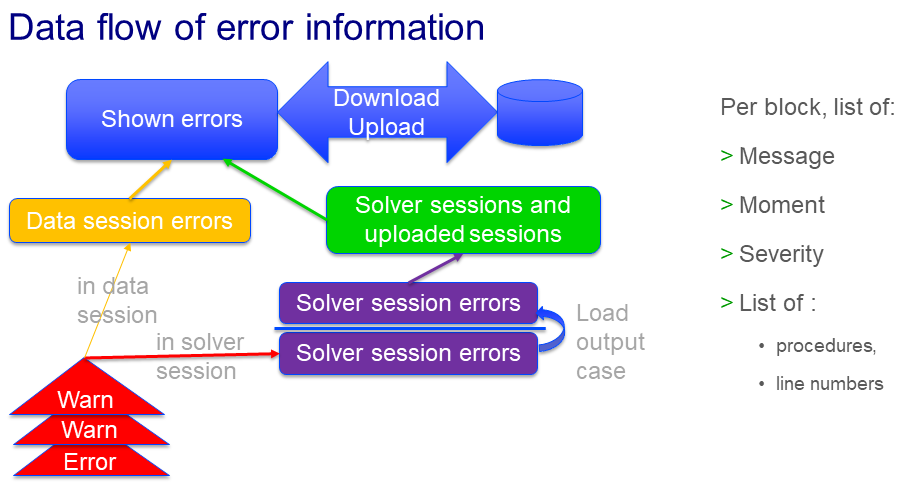Error and Profiling Results as Data
Error and profiler data are stored in AIMMS’ sets and parameters; then serialized.
This way, they are shared between the end-users and specialists that use the application at hand.
This article discusses how this information flows through the GuardServerSession library and which procedures can be used to
store error information.
Data flow of error information
The data flow of errors to support this user interface is organized as follows:

The red triangles are a stream of warnings and errors. These errors move via various steps upwards towards the blue box of errors shown in the User Interface.
There are two paths from “red” to “blue” for this error information, depending on whether the errors are generated inside the data session or in a solver session.
Data session errors
Errors occurring in the data session are collected by the error handler
gss::pr_appendErroringss::dataSessionProfilerErrorDatawhich represents the orange box “Data session errors”When the WebUI page
GSS Session History Managementis opened, the data in the orange box is copied to the blue box, making the error data visible to the end-user.
Solver session errors
Errors in solver sessions are collected by the error handler
gss::pr_appendErroringss::serverSessionErrorDatawhich represents the purple box “Solver session errors”.When the output case is loaded, this error information is loaded in the data session (to identifiers with the same name).
Immediately after, this error information is copied to a slice in the green big box “Solver sessions and uploaded sessions” by the procedure
gss::pr_saveTrackedSessionData.In the WebUI page
GSS Session History Management, the selection widget controls which session’s error data is displayed. When you select asessionIDin the drop down, the corresponding error information is copied to the blue box and displayed.
Data flow of profiler information
The profiler information is captured at the end of a solver session, or at the start of opening the GSS Session History Management.
Then it follows the same path as the error information through the application before it is shown.
Converting errors to data
Use the procedures pr_appendError and pr_appendMessage to convert errors and messages respectively to data in AIMMS identifiers.
The identifiers in which this data is stored are located in:
gss::dataSessionProfilerErrorDatafor data sessions
gss::serverSessionErrorDatafor server sessions
The procedure
pr_appendError(ep_err,sp_prefix)appends the error to the open error collector.Arguments:
Input element parameter
ep_errwith rangeerrh::PendingErrors. This is a reference to the error to be handled.Input string parameter
sp_prefix. This can be used to prefix the error message stored from the message of the error referenced byep_err.
Throws exceptions: None
Return value: None.
The procedure
pr_appendMessage(sp_msg,ep_lev)Appends the messagesp_msgto the open error collector.Arguments:
Input string parameter
sp_msg. The message to be stored.Input element parameter
ep_levwith rangegss::s_messageLevelsand default'info'. The importance level of the messagesp_msg.
Throws exceptions: None
Return value: None.
Converting profiling information to data
By adding ProfilerStart() to MainInitialization the AIMMS process will start collecting profiling information.
The GuardServerSession library uses ProfilerCollectAllData() to collect the profiling information;
no need to add calls to this procedure in your application.